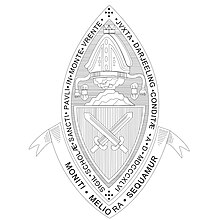St Paul's School, Darjeeling
| St. Paul's School | |
|---|---|
 |
|
| Location | |
|
Darjeeling, West Bengal India |
|
| Information | |
| Type | Independent school |
| Motto |
Moniti Meliora Sequamur Latin: Having been advised, let us follow higher things |
| Religious affiliation(s) | Church of North India |
| Established | 1823 |
| Rector | Joy Halder |
| Gender | Boys |
| Age | 6 to 18 |
| Enrollment | 800 |
| Houses | 12 |
| Colour(s) |
Maroon and dark blue |
| Publication |
The Chronicle The Paulite |
| Former pupils | Old Paulites |
| Website |
http://stpaulsdarjeeling.com/ http://spsdarj.org/ |
Maroon and dark blue
St. Paul's School is an independent boarding school for boys in the town of Darjeeling, West Bengal, India. Entrance tests for admission are held every September. The school follows the ICSE curriculum till the class 10 and the ISC for higher secondary (classes 11 and 12).
St. Paul's School was founded in Calcutta by Archdeacon Corrie at the instigation of John William Ricketts, a local Anglo-Indian leader, and opened at 11 Park Street on 1 May 1823. The school was moved to its present Jalapahar estate in Darjeeling in 1864 with 31 boarders and a few day scholars. At that time, at approximately 7,600 feet above sea level, it was the highest school in the world. A number of its students fought in World War I and World War II.
Bishop Foss Westcott, metropolitan of Bengal, Burma and Ceylon, played an important role in the growth of the school. The Maharajah of Burdwan also made important donations. Over the years a number of estates were purchased and merged with the existing school estate. The Mount Vernon Estate, known as Dawkins, was purchased at the beginning of the 1900s and the Terpsithea Estate in 1955.
The school's original purpose was "to supply a good education at a moderate cost to the sons of Europeans and East Indians". After Indian Independence in 1947 it became a school for wealthy Indians and attracted wealthy students from other countries like Thailand, Bhutan, Europe, Australia, USA, Burma, Hong Kong, Nepal, African countries but of Indian origin, Japan, Korea.
It is compared to Eton College and is known as the Eton of the East. Its reference is because of the existence of the only Eton Fives court outside of England. Its culture and function are very closely related.
...
Wikipedia
